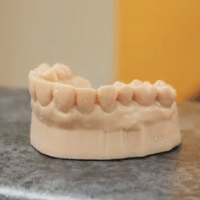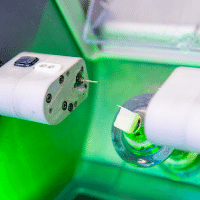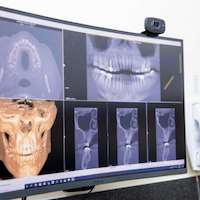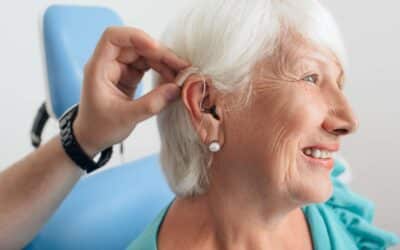Straightening Out Dental Specialists: Who’s Who in the Oral Zoo?

Once upon a time there was just a ‘toothpuller’, who also happened to be a barber. And also a surgeon. Mostly it was someone who was fine with blood, gore and screaming.
And that was just the haircuts.
It was the Colony of Massachusetts Bay in 1630 where the first tooth marks of US dentistry were made with barber-surgeons emigrants arriving from France and England with the settlers. Early dental care was also the realm of ivory turners, one of which began a dentistry practice in 1779 and is considered the first generation American dentist.
Four of Isaac Greenwood’s six sons also became dentists; George Washington’s dentures were eventually made and maintained by John Greenwood – also recipient of Washington’s last remaining natural tooth, gifted to him by 1789’s newly inaugurated President that same year. He had four sets of dentures during his life, having had a partial set since 1781 – not made of wood as is sometimes believed, but of silver and gold, and slave teeth and hippo tusk; apparently softer than elephant. History states that George paid for nine teeth from subjugated Black Africans. The happy gas wafting over that, is that it’s Washington’s acknowledgement of the sacrosanctity and highly personal nature of teeth.
For that to be true he’d have left them in their rightful heads.
The dentures he had were bolted together, had metal fasteners, with springs to force them open. The most likely birthplace of the teeth-of-timber rumour is the appearance stained ivory has to wood. A letter from Greenwood to Washington in 1798 urged more frequent and thorough cleaning. “The sett (sic) you sent me from Philadelphia…was very black..Port wine being sower (sic) takes of[f] all the polish”. Founding Father John Adams attributed Washington’s tooth loss to cracking walnuts but he was no dentist. Historians are more swayed by the smallpox treatment George received when he was a mere slip of a president.
The dentures he had were bolted together, had metal fasteners, with springs to force them open. The most likely birthplace of the teeth-of-timber rumour is the appearance stained ivory has to wood. A letter from Greenwood to Washington in 1798 urged more frequent and thorough cleaning. “The sett (sic) you sent me from Philadelphia…was very black..Port wine being sower (sic) takes of[f] all the polish”. Founding Father John Adams attributed Washington’s tooth loss to cracking walnuts but as he was no dentist, really what would he know. Historians are more swayed that the effect of smallpox on his immune system is largely responsible for the state of his teeth.
Brought over by the British and contracted by George in Barbados in 1771, it’s largely responsible for his troops winning the War of Independence too; maybe “you win some, you lose some” has been shortened from the original that included the words “war” and “teeth”.
There is a protein-on-protein interaction between the smallpox virus and humans. It is a particularly devastating pairing that activates the gene switches not only for the growth and survival of both healthy and cancerous cells, but for immunity responses and inflammation. Washington was soothing his tuberculosis and smoothing the irony when it was in the warmth of the Caribbean air that he became poxxed. By that time in his life he’d already had diphtheria, dysentery, malaria, and what appears to be recurring tonsillitis. Without necessarily letting the variola virus off the hook, it is not beyond the realm of reason for gum disease to have developed, having had a compromised immune system, and more than a decade of defective teeth.
For the First President to speak from his disfigured mouth would have been painful – filled with slips and clacks and uncomfortable mispronunciations in a very different way to the 45th President of the United States who probably should’ve taken laudanum for it too.
Like dotcom entrepreneurs of the 1980s, other craftsmen turned to aspects of dentistry in order to make ends meet. Silversmith, early industrialist and Founding Father Paul Revere too, followed the call of the oral cavity craftsman.
I find Founding Fathers found confounding things to do.
Seven years after the Seven Years’ War and seven years before he to-arms-to-arms-the-British-are-coming’ed, Paul Revere was a 33-year-old husband with ten children to support. Tradesmen, merchants and artisans reaped the benefit of wartime commerce during a war that lasted nine years from 1754 and named in a way where two years of it were either ignored, or maths was a little different in the day.
Fortunately it was more complicated than that because war always has to be. Otherwise it wouldn’t make any sense to have them.
In the five years since it had ended, and with the Stamp Act of 1765 further depressing the economy Revere owed money, and his creditors wanted his 19 North Square, Boston, Massachusetts, house.
So he hung out his shingle as a dentist, proficient in teeth cleaning, and false teeth in ivory or animal; the wiring of which he learned from “Operator for the Teeth” John Baker, who happened to be cohabitating with a friend of Revere. Only practitioners arriving from Europe used the term “Surgeon-Dentist” which wasn’t permanently adopted until 1767.
In 1772 “Mr. Baker Surgeon Dentist” arrived at Mount Vernon to stay several days and remove a number of teeth for poor George for the charge of £5. Even at today’s value of roughly £800 it’s still insanely cheap for a few days of individual, at-home 24-hour dental care. Consider, however, that nitrous oxide was still only being used for entertainment – it would be twenty years until it became laughable for laughing gas to have not been used in dentistry earlier. And there was no ether either. Washington was essentially paying to be willingly tortured in his own home.
So make what you will of the five quid.
In 1771 The Natural History of the Human Teeth was published by Englishman John Hunter, the father of modern surgery. He pioneered the transplantation of one individual’s tooth to another – a widely practiced treatment because of Hunter’s remarkable reputation. It proved to be the first unsuccessful attempt at human tissue transplantation and it lead to English dentist Joseph Fox identifying transplantation “rejection phenomenon” in 1806.
If it wasn’t for someone wanting to swap some teeth, organ donor registries might have been all about Hammonds and Yamahas.
In 19th century Europe, chief among dental innovations was the development of porcelain for use in dentures. This economical and very appealing alternative to tooth replacement procedures reliant on corpses and ivory poachers is the legacy of Italian dentist, Giuseppangelo Fonzi.
Aaaaaayyye… and no Ralph Malph in sight.
Advances in equipment, materials, and techniques were rapid. In 1864 vulcanised rubber became the viable substitute for costly gold dentures and the 1871 introduction of the foot-treadle supplanted awkward handheld versions, and gave dentists the ability to create intricate and aesthetically pleasing restorations.
By the first quarter of the 19th century, the United States lead the world in dental development. By 1840 the American Journal of Dental Science, had been launched, the first dental school established, and the American Society of Dental Surgeons founded.
Dentistry was at last a true profession. The broad strokes of those assisting its evolution over the last 182 years are medicine, science, physics and space exploration. Oral care has technologically and biologically advanced to being able to regrow your own teeth within a decade.
There’s a bit of specialisation that goes into, and comes out of a trajectory like that.
The profession itself is primarily concerned with the prevention and treatment of oral disease. It includes disorders of the supporting structures of the teeth, and soft tissue issues of the mouth. It encompasses skeletal malformations of the jaw, neck and face, and the misalignment or absence of teeth, including birth anomalies of the oral cavity.
General practice dentists and orthodontists are the two specialists most people are familiar with, not least by having gone to them. While orthodontists manage tooth movement, dentofacial orthopaedics involves the guidance of developing facial bone growth, largely during childhood. Where orthodontics has braces, orthopaedics has headgear and expanders. It sometimes precedes orthodontics, but more commonly is a same-time procedure. So kid in braces and headgear has a whole lot going on aside from melting glaciers and the probability of no pandas in a post-pandemic world.

That’s a skill honed from talent that deserves a crown.
Periodontists are at the other end of the paediatric dentist’s age range, treating diseases of the gum – which for almost 50% of the world’s adult population is the reality they wish they didn’t have. Root planing and scaling is an adventurous-sounding way of the diseased and damaged tooth tissue they remove below the gum line. Periodontists also perform pocket reduction surgery, bone grafts and laser gum surgery.
Prosthodontists have the happy job of basically restoring smiles. Cosmetic dental specialists, they treat complex matters of jaw disorders and the restoration and replacement of teeth using crowns, caps, bridges, implants and dentures. Specially trained prosthodontists treat head and neck deformities as well as missing parts of the jaw and face, whether genetic or traumatic injury.
Endodontists are highly skilled in understanding and treating the pulp, blood vessels, nerves, and connective tissue of the teeth. Their most common procedure is root canal therapy, which can also be performed by a general dentist. Where they supercede, is their ability to perform an apicoectomy – also known as root end surgery. This is the removal of a tooth’s root tip and surrounding tissue, a necessary procedure when root canal therapy has failed, and residual inflammation or infection reaches the jawbone.
Oral and maxillofacial surgeons are the apex dentists of specialised care. They treat rare conditions of the teeth, mouth, face and neck that number almost sixty. Their realm of expertise is predominantly in cancers, fractures, deformities, fistulas, tumours and cysts of the hard and soft tissues comprising the mouth and head.
Dentistry is a very high-risk, high-stress profession. Work is often with fearful patients, providing therapies and restorations that succeed or fail based upon microns, and aftercare techniques that may or may not be adhered to. It takes years of higher education to gain the knowledge and proficiency, then decades of experience and continuing study to become an expert in a chosen field, and that extends to anaesthesiology and pathology.
To be a dentist requires a working knowledge of medicine, physics, substances and artistry; with each demanding high attention to great detail.
If you’ve never needed a dental specialist, you’re doing very well. If you ever need a dental specialist, you’re doing very, very well when nobody’s getting a haircut before you.
The content has been made available for informational and educational purposes only. Plaza Dental does not make any representation or warranties with respect to the accuracy, applicability, fitness, or completeness of the content.
The content is not intended to be a substitute for professional personal diagnosis or treatment. Always seek the advice of your dentist or another qualified health provider with any questions you may have regarding a dental or medical condition. Never disregard professional advice or delay seeking it because of something you have read or seen on the Site.
Services we mentioned:
Related Articles
Propolis Can Help Manage Gingivitis And Periodontal Disease
Propolis. Bee glue. The resinous tree, branch and leaf raw materials of certain plants that bees collect to make the...
Dental Implant Hearing Aids
It’s a study published in the Journal of the Acoustical Society of America rather than the Journal of the American...











